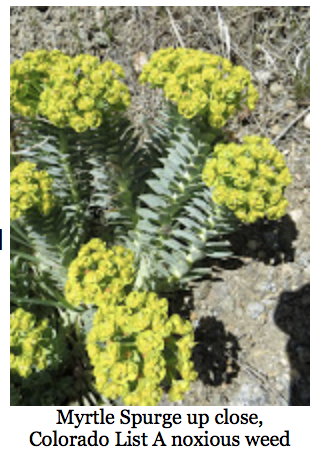Colorado Mountain Gardner
Colorado Mountain Gardener |
| Why some weeds are slated for eradication
Posted: 12 Jul 2018 02:09 PM PDT by Irene Shonle CSU Extension Gilpin County Why are there some weeds, such as List A noxious weeds myrtle spurge, orange hawkweed, and others, required by state law to be eradicated? The answer is long and complicated. First, we must start with what makes a weed a noxious weed – it is a plant that is alien (not from this country) that has been shown to cause problems in natural or agricultural settings. To be declared noxious, they have to be proven bad actors, and only after scientists have reviewed the data, and it has passed through a legislative process. It is not just “someone’s” opinion. Because these weeds are not from here, they do not deal with the same suite of insects and diseases that our native plants have to deal with, so they have a competitive advantage. They usually have a nasty tendency to form monocultures and crowd out native plants. This is certainly the case with myrtle spurge (and most other noxious weeds); if it is left alone, it will take over large areas over time. Next, we must look at the relative benefit to the ecosystem of native plants and alien plants. Doug Tallamy, a professor from the University of Delaware (author of Bringing Nature Home), has been studying how native plants support the entire food chain and how alien plants do so to a much lesser degree. His definition of a native plant is a functional one: “a plant that has evolved in a particular place long enough to be able to establish the specialized relationships that create an ecosystem”. Noxious weeds, by virtue of being alien, are newcomers to the area, and do not have these relationships. Native plants provide the bottom of the food chain, and the insects that eat the plants are the next rung – but they can’t eat just any plant. According to Tallamy, “with few exceptions, only insect species that have shared a long evolutionary history with a particular plant lineage have developed the physiological adaptations required to digest the chemicals in their host’s leaves. They have specialized over time to eat only the plants sharing those particular chemicals.” Alien plants like noxious weeds do not have the chemical footprint in their leaves that spells ‘food’ for most insects. One of the reasons we are seeing a sad decline in bird populations (overall, 40 percent of the world’s 11,000 bird species are in decline, according to the 2018 State of the World’s Birds report) is because so many of our plants around us are now not native – either noxious weeds or beloved garden plants. Almost all birds, even if the adults are seed eaters or fruit eaters, require thousands of insects to raise even one clutch of birds. Weeds such as myrtle spurge may have pollinator visitation, but they occupy space that would otherwise be used by native plants which provide pollinator services AND are host plants for many different insects. Also, research from the Xerces Society shows that native plants are four times more likely to attract native bees than exotics – and native bees are also suffering declines, even though the non-native honeybees get all the press. So, while it may seem on the surface that removing one plant would reduce biodiversity (we all know basic subtraction, right?), the natives do a much better job of supporting the myriad insects and birds that depend on them. In fact, Tallamy’s research shows alien plants support 29 times less biodiversity than do native plants. The next question is why does the law state that list A weeds must be eradicated? This is because these weeds have relatively small populations so far in the state. That means we should not have to expend a lot of time and effort in bringing these weeds under control if we act now. It also means that we probably don’t have to do a great deal of remediation afterwards, because their populations aren’t that large; the native vegetation will be able to take over again with little to no intervention. We don’t want to leave pockets of these weeds around, because those populations would spread into new areas (they are weeds, after all), and weed managers would continuously have to be putting out these small (or sometimes large) fires. Sure, we could wait until a weed like myrtle spurge gets as bad here as it is in Utah: “we waited too long and this thing is now incredibly entrenched, and there just doesn’t seem to be an answer,” according to Utah Native Plant Society’s Tony Frates in reference to the huge monocultures that have formed in the Wasatch. Then we would have lost our window of opportunity. List A weeds are sort of like a disease – in a perfect world, we would be able to completely eradicate diseases such as we have done with small pox, rather than dealing with the trauma and loss of life of epidemics, and rather than continuously having to vaccinate against them. If we can deal with these weeds now while their populations are still small, we don’t have to worry about them coming back, and we can spend time and energy on either dealing with some of the other weeds, or habitat restoration, or some other productive use. That is why some weeds are required by law to be eradicated. Irene Shonle is the County Extension Agent at the CSU Gilpin County Extension Office located at the Exhibit Barn in Gilpin County. For more information, visit www.gilpin.extension.colostate.edu. |




